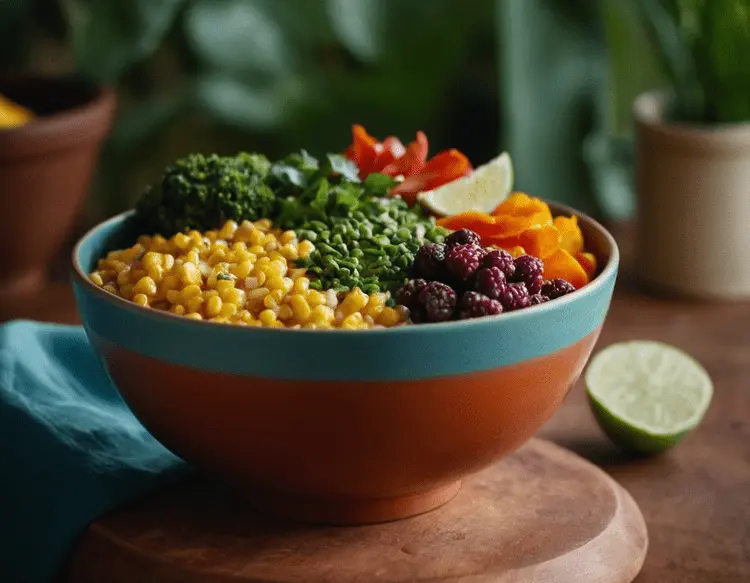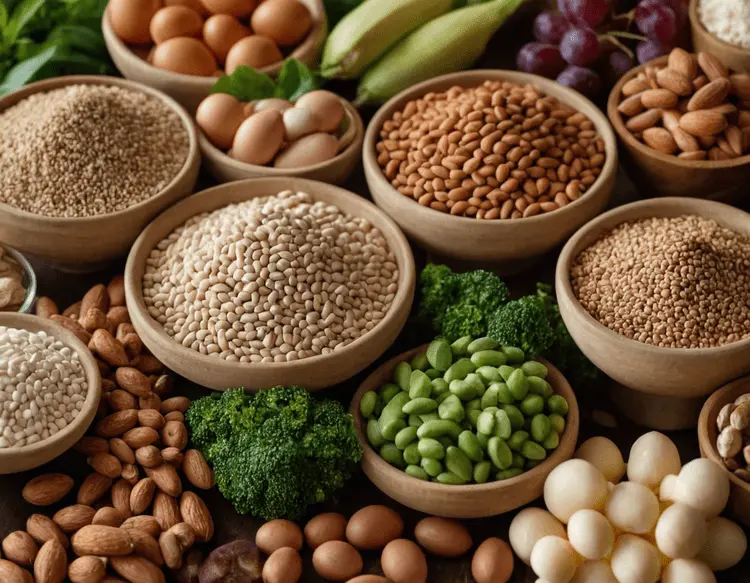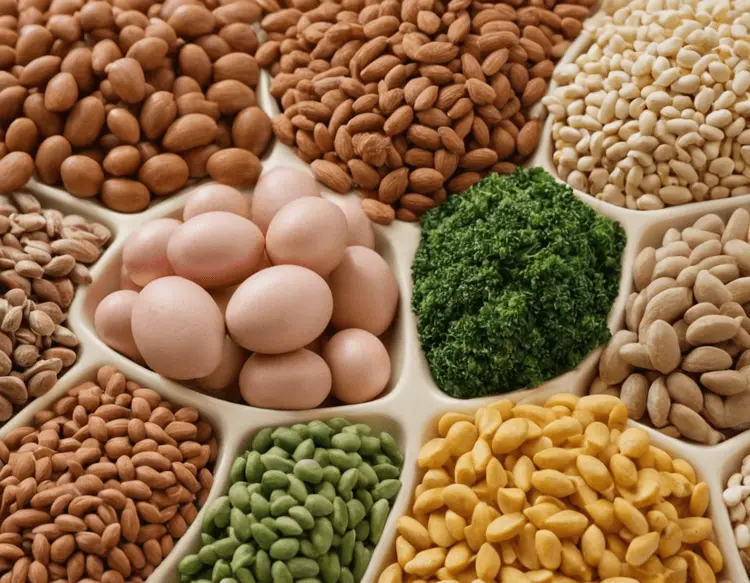Confused about incomplete proteins and how they fit into a plant-based diet? Worried you won’t get enough essential amino acids?
Fear not! Incomplete proteins can still be valuable sources of protein, and you don’t have to give up delicious plant-powered options.
This guide will unveil the secrets of incomplete proteins, show you how to create complete protein meals by combining plant-based sources, and unlock the health benefits of going green with your protein intake.
Explore how to achieve a balanced diet rich in vegan and vegetarian protein sources, all while making sustainable choices!
Incomplete Proteins: The Short Story
- Missing aminos: Lack essential building blocks
- Mix it up: Combine plants for complete meals
- Variety is key: Focus on different sources daily
- Balance matters: Don’t stress every meal
- Plant-based benefits: Reap health advantages
Understanding Protein Basics

Ever wondered what keeps your hair shiny, your muscles strong, and your body functioning optimally? It’s protein! This essential macronutrient plays a starring role in nearly every bodily process, from building and repairing tissues to creating enzymes and hormones.
Think of protein as the building blocks for your body. It’s made up of smaller molecules called amino acids, which are linked together in specific chains.
There are 20 different amino acids, and our bodies can actually synthesize (make) some of them. But there are also 9 essential amino acids that we must get from our diet. This is where the concept of complete and incomplete proteins comes in.
Complete proteins contain all nine essential amino acids in the right proportions. Animal products like meat, poultry, fish, eggs, and dairy are excellent sources of complete proteins.
Incomplete proteins, on the other hand, lack one or more essential amino acids. This doesn’t mean they’re bad for you, though! Plant-based foods like beans, lentils, nuts, seeds, and whole grains are all fantastic sources of incomplete proteins.
So, can you still get enough protein if you don’t eat animal products? Absolutely! The key is to understand complementary proteins.
By combining different plant-based protein sources throughout the day, you can ensure your body gets all the essential amino acids it needs.
Want to learn more about creating complete protein meals from plants? Stay tuned for the next section where we’ll dive deeper into this topic!
In the meantime, have you ever struggled to meet your protein needs? Share your experiences in the comments below, or tag me on social media!
Conquered the world of incomplete proteins? Now let’s unlock the powerhouse plant-based sources that fuel your body and taste buds! Dive into our guide on Best Plant-Based Protein Sources and discover the tastiest ways to get your daily protein fix.
Unveiling Incomplete Proteins: Demystifying Plant-Based Powerhouses
Have you ever heard the term “incomplete protein” and wondered what it means for your diet? Incomplete proteins simply lack the entire spectrum of nine essential amino acids our bodies can’t produce on their own.
But wait, does this mean plant-based eaters are destined for protein deficiency? Not quite!
While animal sources like meat, poultry, and eggs are considered complete proteins, the plant-based world offers a treasure trove of incomplete proteins with unique benefits. Think legumes (beans, lentils, peas), nuts, seeds, and whole grains.
These superstars are packed with essential nutrients like fiber, healthy fats, and vitamins.
But here’s the key: the magic happens when you combine these plant-based powerhouses! By strategically pairing incomplete proteins, you can create complete protein meals that provide all the essential amino acids your body needs to thrive.
For example, rice and beans, a classic and delicious combo, is a nutritional powerhouse. This is because rice is low in lysine but high in methionine, while beans are the opposite. Together, they create a complete protein profile!
So, what are your thoughts on incomplete proteins? Have you explored creative ways to combine them in your meals? Share your favorite plant-based protein combos in the comments below, or tag me on social media to keep the conversation going!
Let’s unlock the full potential of these nutritional gems together.
Creating Complete Protein Meals from Plants: Power Up Your Plate!

Ever wonder how to get all the essential amino acids your body needs from a plant-based diet? It’s a common question, and the answer might surprise you!
While animal protein sources like meat and dairy are considered “complete proteins,” containing all nine essential amino acids.
Many plant-based options are classified as incomplete proteins. But fear not, plant-powered friends! There’s a simple trick to creating complete protein meals that goes beyond just reaching for the tofu scramble.
The magic ingredient? Complementary proteins!
These are plant-based protein sources that naturally “complement” each other by containing different essential amino acids in higher amounts.
By combining these clever pairings throughout your day, you can ensure your body has all the building blocks it needs to thrive.
Ready to unlock the power of plant-based protein? Here are some winning combinations to get you started:
- The Classic Duo: Rice and beans are a match made in protein heaven. This iconic pairing provides a complete protein profile, with rice being higher in the amino acid methionine and beans boasting more lysine.
- The Dynamic Grains: Quinoa, a nutritional powerhouse, is considered a pseudo-cereal because of its near-complete amino acid profile. Paired with vegetables like broccoli or asparagus, which are lower in certain essential amino acids, you create a well-rounded protein punch. Discusses general protein intake recommendations).
- The Nutty Spread: Peanut butter on whole-wheat toast is a delicious and convenient snack, but did you know it’s also a complete protein party? Peanuts are rich in lysine, while whole wheat bread offers a good dose of methionine. This combo is a great example of how combining simple ingredients can create a complete protein option.
Feeling creative? Experiment with your own complementary protein pairings!
Explore different legumes, nuts, seeds, and whole grains to discover your favorites. Remember, variety is key to a balanced diet. So, tell us in the comments below, what are your favorite plant-based protein combos?
We can’t wait to hear your ideas! #plantprotein #completeprotein #getcreative
Incomplete Proteins: Beyond the Basics
Beyond the Building Blocks: Putting Incomplete Proteins into Perspective
So, you’ve wrapped your head around incomplete proteins and understand they lack a complete set of essential amino acids.
But what does this mean for your daily diet? Is achieving complete protein a constant mealtime challenge, especially if you’re following a plant-based lifestyle?
Relax! Here’s the good news: Your body is an amazing protein recycling machine. It can store excess amino acids from one meal and use them later to complete protein synthesis from another. This means you don’t necessarily need to consume complete proteins at every single meal.
Variety is Key: Building Complete Proteins Throughout the Day
The key is variety! Aim for a balanced diet rich in various protein sources throughout the day. This ensures you’re getting a good mix of all essential amino acids.
For example, a morning oatmeal with nuts and seeds provides complementary proteins, even though each source alone is incomplete.
Protein Requirements: How Much is Enough?
Thinking about protein requirements? The World Health Organization (WHO) recommends a daily intake of 0.8 grams of protein per kilogram of body weight for healthy adults.
This is a general guideline, and your individual needs may vary depending on factors like activity level and age.
Special Considerations: Athletes and Vegans
Athletes and vegans often have higher protein needs. Plant-based protein sources tend to be lower in digestibility compared to animal sources. To compensate, athletes following a plant-based diet may need to consume slightly more protein.
The American College of Sports Medicine (ACSM) offers helpful resources on protein intake for athletes.
Protein Deficiency: Signs and Solutions
Protein deficiency is rare with a balanced diet, but it can occur. Symptoms like fatigue, muscle weakness, and impaired wound healing might indicate a deficiency. If you’re concerned about protein intake, consult a registered dietitian for personalized guidance.
You’ve Got This: Putting It All Together
Remember, you’ve got this! By incorporating a variety of protein sources and considering your individual needs, you can ensure your body gets the essential building blocks it needs to thrive.
Beyond Plants: Other Sources of Incomplete Proteins
We’ve explored the world of plant-based incomplete proteins, but what about other options? While plants dominate the incomplete protein scene, there are a few unexpected players to consider.
- Dairy delights: Don’t forget dairy products like milk and cheese! They’re incomplete proteins, but they provide a good source of calcium and other essential nutrients. Remember, moderation is key for overall heart health.
- Egg-cellent source: Eggs are a classic complete protein source, but did you know the yolk itself is actually incomplete? The egg white, on the other hand, boasts a complete amino acid profile. This means a whole egg offers a good balance, providing a variety of essential amino acids.
- Beyond the usual: Ever heard of quinoa? This wonder grain is a nutritional powerhouse, considered a pseudo-cereal because of its complete protein profile (with a slightly limiting amount of lysine). Mushrooms may also surprise you! Certain varieties, like portobello mushrooms, contain a good amount of protein and all essential amino acids in decent amounts, making them another interesting option.
Health Benefits of Plant-Based Proteins: Beyond Building Blocks

Think plant-based proteins are just about getting enough essential amino acids (like those found in complete proteins)? Think again! Swapping animal proteins for plant-based options can offer a surprising range of health benefits.
Heart-Healthy Hero: Reducing Your Risk of Heart Disease
Studies suggest that plant-based proteins may be linked to a lower risk of heart disease. This is because they’re often lower in saturated fat and cholesterol compared to animal sources.
Think about it: Swapping a fatty steak for a lentil stew can make a big difference for your heart health.
Fiber Fiesta! Gut-Friendly Benefits of Plant-Based Proteins
Many plant-based proteins are also packed with fiber, a gut-friendly nutrient that aids digestion and promotes feelings of fullness. This can help with weight management and keep you feeling satisfied throughout the day.
For example, a bowl of beans and brown rice provides a powerful combination of protein and fiber, keeping you energized longer.
Weight Management Wonder: Plant-Based Proteins for a Balanced Diet
Speaking of weight management, plant-based proteins tend to be lower in calories than their animal counterparts. This can be a helpful factor for those watching their weight.
Consider this: A grilled chicken breast might have around 250 calories, while a cup of lentils contains only about 230 calories and offers a similar amount of protein.
Unlocking the full potential of plant-based protein means maximizing essential amino acids for optimal health. “Complete Protein Sources for Vegans” reveals the plant-based powerhouses that fuel your body and unlock a world of health benefits. Don’t miss out!
Environmental Impact: A Sustainable Choice for Your Plate
Did you know that animal agriculture can have a significant environmental impact? Choosing plant-based proteins can be a more sustainable dietary choice, reducing your carbon footprint.
For instance, raising livestock requires significant resources like land and water. Opting for plant-based proteins can help minimize your environmental impact.
Explore the Delicious World of Plant-Based Proteins!
So, what are you waiting for? Explore the delicious world of plant-based proteins! Ready for some inspiration? Check out online resources for plant-based recipes.
Let me know in the comments! Have you noticed any health benefits since incorporating more plant-based proteins into your diet? Share your favorite recipes and tips for a plant-powered lifestyle!
Incomplete Proteins Explained
Confused about incomplete proteins? Don’t worry, this FAQ section will clear things up!
Nope! Your body stores amino acids and uses them later. Focus on variety throughout the day.
Think again! Beans, lentils, tofu, nuts, seeds, and whole grains are all protein powerhouses.
Fatigue, muscle weakness, and slow wound healing could be signs (consult a dietitian if concerned).
Absolutely! Well-planned plant-based diets are packed with nutrients and can be very healthy.
Examples include: beans, nuts, seeds, grains (like rice), and some vegetables
Another term for incomplete protein, meaning it lacks all nine essential amino acids.
Absolutely! They can be part of a healthy diet, especially if combined with other protein sources throughout the day
Yes. Soybeans themselves are incomplete, but soy products like tofu and tempeh are considered complete proteins.